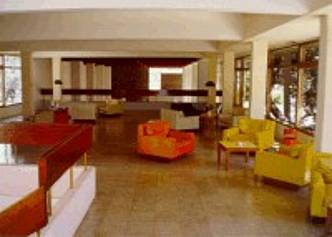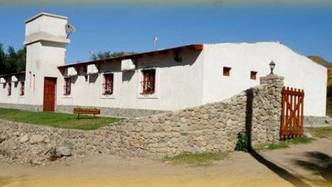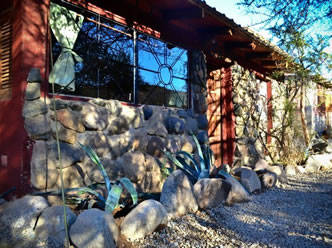La Mexicana mine
The trip to La mexicana mine starts in Chilecito. As we leave the city, our vehicle rides over a dusty rubble road to the town of Santa Florentina.
The journey takes only half an hour to the spot called Las Talas, a small site located at the bottom of the Famatina mountain range. That is where we start walking. It is seven o’clock in the morning and the sun falls down over the mountains, lighting up the intensely green valley, while the last drops of dew survive on the bushes leaves. At a distance, under a foggy cloak, we make out the first towers of the cable car. In a few minutes we reach the edge of the rivers that form whimsical figures on the large plain valley moistened by recent raindrops. Sunshine reflects in the waters of the Amarillo River, which acquire a bright ocher tinge when going through the narrow passes and caves of the area, very rich in minerals. At this point, it is necessary to cross the river and, so as not to get wet, our guide, Alejo Pihel improvises a footbridge made with rocks tinged in yellow, just like the river. To one side of the path, a limestone hill has changed its color in the last few days and has adopted dark grey shades, due to the humidity of the rain. Our walk continues along a rubble path till we reach a vast plain carpeted with grass, where we decide to have a rest. Lying on our backs in the shade of a huge four-meter-high tree, we discover two superb condors hovering with their open wings, plotting circles in the air till they become a tiny spot in the sky.
When recovering our energy, we resume the walk, by the cable car laying. Over the edge of the hills we can see the huge Eiffel-style braided iron towers, interwoven by steel cables, till they get lost in the bowels of the mountain. As we ascend, the vegetation gets thicker and thicker, and the plum trees, wickers, acacias, poplars and walnut trees adorn the foot of the mountains. The landscape emanates an orange scent, a mixture of incayuyo and cedrón, which grow all over the area. At noon, we interrupt the march and, at the foot of a hill, on a small plateau covered with grass, the guide spreads our lunch. Two giant and lonely chestnut trees offer their fruit scattered on the grass. In front, on top of a mountain, we can see the third cable car station -a rusty tin house with a chimney covered with soot, next to an iron tower. We continue walking after lunch and, as we enter a narrow pass, the sun hides behind a thick cluster of clouds. We are reached by the breeze and the coolness of the rain. Wrapped in our waterproof clothes, we go up and down a path along the edge of the hills. As we turn back, we can see a great valley opening, shielded by giant mountains. Once in a while, we stop to have a short rest and enjoy the scenery of the landscape: the scent of moistened earth, the freshness of the creeks with their crystal clear torrents going through the bowels of the narrow passes, and the humid smell emanated by the rain. In some parts, the path is nothing but a small step on the edge of a very deep rocky and steep slope. There, the thick branches of the trees hardly allow the sky to percolate through some chinks, and lighten the very dark trunks and the grey leaves of the wicker trees. High in the mountain, among a crowd of ferns, a long and thin thread of water throws itself into the void in a suicidal jump. A Walk in the Clouds All through the journey, the cable car towers rise as colossal guardians of a treasure. At this point, we walk among the clouds and the dream of touching the sky with our hands becomes true. After seven hours of climbing, the fourth station appears high in the mountain. It is called Siete Cuestas (seven slopes) after the path we have gone along. When we stop, the first stimulus that seduces us is brought by the absolute silence surrounding this site, which is only interrupted by the soft patter of the rain against the iron. The most pretentious work of engineering in the country rises before us, sunk in abandonment for years. We visit the remains of the station, built in zinc plates and covered with wood, next to an iron joint from which some rusty wagons are still hanging. The guide sets up the camping site and lights a bonfire, while his partner improvises a grill for the barbecue. During the banquet, which in this context has a different taste, the appointment with dusk is equivalent to a sacred ritual made exclusively for those who dare to make this journey. At dawn, the following day, we are woken by the gentle pattering of the raindrops on the tent. We start the return and the downpour escorts us during the whole descent, which takes three hours. When we get to the Amarillo River, we discover that its volume has increased due to the storm. As we are already soaked, we decide to cross it without using the footpath, and the water reaches our knees. We have to reach the truck that will take us to the city of Chilecito. Later, back in the civilized world, a tickling vertigo in our souls certifies that in fact we have been, for one day, at Heaven’s door.
Sandra Bonetto
Marcelo Sola
Contact of the excursion or tour
Dirección de Turismo
Castro y Bazán, Chilecito, La Rioja, Agentina
Phone: +54 3825-422688

























